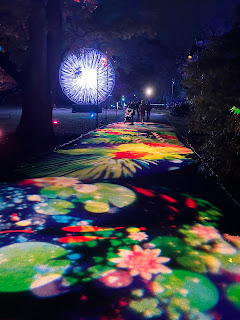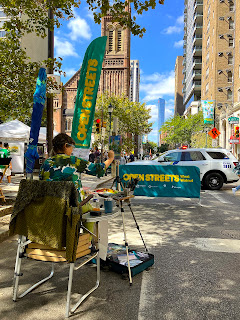 |
| Eating sushi on the tarmac. |
On September 22, a large screen appeared on the northern section of 18th Street, and Eagles fans with strong stomachs got to watch their team win a game - 15 to 12 over the Saints.
I managed to visit Open Streets: West Walnut on three of the four Sundays. I spent the most time there on the third Sunday of September, which coincided with the last day of the Rittenhouse Square Fine Art Show. That was a particularly busy weekend. During the afternoon there was a small brass band playing jazz in the center of the square, and down by the goat statue we had the swing dancers, also with a live combo.
Streets Can Be Fun
Why do people like open streets? Because they're fun. Fun is a thread that runs through and ties together the many ways people are trying to reimagine our streets. People like biking because it's fun. They like eating outdoors because it's fun. They like hanging out in the middle of a street with other people. Perhaps it's just the novelty of an outdoor living room, but it is fun.
Come with me to the Casbah, Charles Boyer did not say in the movie Algiers, but he might as well have. The Casbah was a place of freedom. Open streets are places of freedom.
Open Space That's Not Scary
So open streets are attractive; they are also places of safety. Center City Philadelphia is short of open spaces that are safe and attractive. We have Independence Mall, but few people spend time there unless there's an event like Barack Obama's speech on April 18, 2008, which drew 35,000 people.
The mall is pretty, but it's surrounded by streets full of motor vehicles that are busy shifting into, or out of, Interstate mode. Something like an island surrounded by sharks. And for many years, many important people saw the mall simply as a viewshed. Stand in the middle of it, and you can take a very pretty picture of Independence Hall. Then what do you do?
People have been working on answers. In September, a coalition led by the Independence Historical Trust unveiled a proposal to redesign the whole historical area of Philadelphia that has as its heart Independence National Historical Park, Independence Hall, and Independence Mall. The redesign extends east from the mall to the Delaware River, which means that it will be covering Philadelphia's nineteenth-century history, as well as the eighteenth century.
It's a pretty exciting plan, focused on turning the area into a pedestrian-priority zone, so that tourists who have been told that we are a very walkable city can come here and actually walk around without having to deal with the bizarre behavior of Philadelphia motorists at every turn.
The plan incorporates and expands upon a redesign centered on Market street in Old City that was proposed in 2016 and is moving ahead; construction should start this year.
I'm particularly pleased to note that Commerce street is included in these plans. Commerce street is a little pedestrian walkway located between Market and Arch. It runs east from Fifth street, past the Congregation Mikveh Israel on the north and the former Faith and Liberty Discovery Center on the south. It crosses Fourth street and then, in the middle of the 300 block, splits in several directions. I fell in love with Commerce street back in 2018, when I was working on a story that wound up with the title Permeable Blocks. I had the positively brilliant idea to open a gelato stand at the point where Commerce street splits in three directions. I wanted to call it the Dead Squirrel Cafe, after a squirrel who slowly turned into a skeleton while I was writing the story.
Currently, Commerce street is an underutilized space. The key to activating it is installing mid-block crosswalks on Fifth and Fourth streets.
I'm informed that the Commerce street project is fully funded, and it looks like construction may be complete for the 2026 celebration of the country's 250th birthday.
Where Do We Go from Here?
So progress is possible, and I think Independence Mall and Old City may be getting ready to give the Rittenhouse Square area some serious competition for the title of best open space in Philadelphia.
Open House: West Walnut provides an excellent example of temporary closure of major streets. For four Sundays in September it provided a massive increase of open space - well programmed space - directly connected to Rittenhouse Square.
I'm reliably informed that the square itself covers only six acres. I did some very rough calculations, and came to the conclusion that the street closures added well over an acre. And it was well used.
There are other possibilities within the world of open streets. I've written a lot about our little streets, often called alleys. A lot of these alleys could follow the example of Stone Street, a pedestrian street in lower Manhattan, where the neighboring restaurants use the street just as Parc did during the West Walnut open streets, only every day. Oktoberfest is apparently a really big deal.
It strikes me that Drury street, a one-block street that lies two blocks southeast of City Hall, between Juniper and 13th, is well on its way to being a de facto open street. One of the keys here was repurposing part of an open lot in the mid-block as a corral for the block's dumpsters. This opportunity will not arise in every block.
The 1500 block of Sansom street was a huge success as an open street during the Covid crisis. It could be brought back in a New York minute.
Intriguing but more challenging are the 1400, 1700, and 2000 blocks of Moravian, a little east-west street that runs just north of Walnut and south of Sansom. The architecture on the 1400 block, next to the Union League, is among the most memorable in the city. It just needs to be cleaned up and have a restaurant or two on Walnut decide to utilize the existing facades on Moravian as a second front door.
Here's an artist getting in a little plein air painting on Walnut Street.
See also Alleys, Gordon Cullen and the Outdoor Floor, Small Streets Are Like Diamonds, Philly Plein Air, A Few Deft Touches for Back Streets, Come for the Sights, What Should We Do With the Humble Dumpster?


















